| Article ID | Journal | Published Year | Pages | File Type |
|---|---|---|---|---|
| 3067519 | The Lancet Neurology | 2008 | 14 Pages |
SummaryCerebellar infarction is an important cause of stroke that often presents with common and non-specific symptoms such as dizziness, nausea and vomiting, unsteady gait, and headache. Accurate diagnosis frequently relies on careful attention to patients' coordination, gait, and eye movements—components of the neurological physical examination that are sometimes omitted or abridged if cerebellar stroke is not specifically being considered. The differential diagnosis is broad, and includes many common and benign causes. Furthermore, early-stage posterior fossa ischaemia is rarely seen with brain CT—the most commonly available initial imaging test that is used for stroke. Insufficient examination and imaging can result in misdiagnosis. However, early correct diagnosis is crucial to help prevent treatable but potentially fatal complications, such as brainstem compression and obstructive hydrocephalus. The identification and treatment of the underlying vascular lesions at an early stage can also prevent subsequent occurrences of stroke and improve patients' outcomes. Here, we review the clinical presentation of cerebellar infarction, from diagnosis and misdiagnosis to patients' monitoring, treatment, and potential complications.
